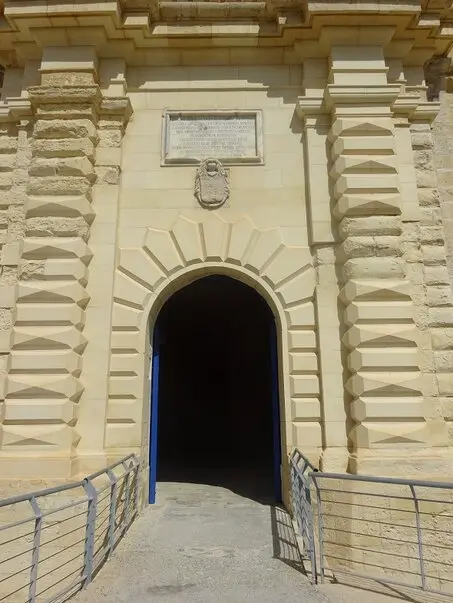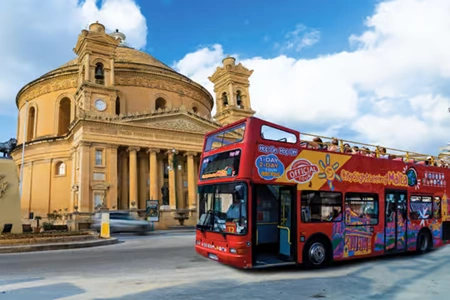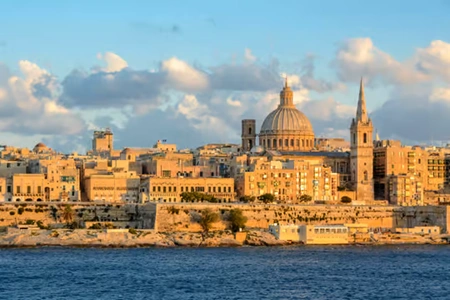The History of the People on Malta and Its Temples
Let me take you back to the end of the last Ice Age, which was around 12000 years ago. At that time, Malta was cooler and drier than it is now, the Mediterranean Sea was significantly smaller due to lower sea levels, and land bridges existed, allowing travel on foot to what is now Italy. The population around the Mediterranean mainly consisted of hunter-gatherers who were on the brink of the agricultural revolution.
For a long time, Malta had the oldest free-standing megalithic monuments in the world—these sites are older than the pyramids and Stonehenge. However, that record has been surpassed by the recent discovery of Göbekli Tepe, which has an impressive age of around 11500 years. Göbekli Tepe is located in the southeastern part of the Anatolia region in Turkey.
I must admit that my knowledge falls short if you ask where the builders of Göbekli Tepe acquired their construction knowledge and tools. The temples are unique architectural masterpieces, considering the limited resources available to their builders.
Għar Dalam is a cave and museum in Malta where many prehistoric remains have been found. This museum, along with the cave, provides an overview of Malta’s natural history. Two molars were also discovered there, which Dr Anton Mifsud had examined, and they turned out to belong to Neanderthals.
Human skulls with elongated features have been found in Ħal Saflieni and elsewhere on Malta, dated to around 4000 BC. These long skulls are known as dolichocephaly. These highly advanced Maltese temple builders had elongated skulls, similar to the pharaohs of Egypt’s Old and New Kingdoms.
DNA analysis has shown that the inhabitants of the Maltese islands first settled around 5900 BC. These settlers came from Africa, Europe, and various parts of the Mediterranean. These early inhabitants were healthy and robust, with excellent teeth. Research by Professor Caroline Malone also revealed that the people cared for their wounded, sick, and elderly. Despite advanced bone deterioration and chronic pain, the inhabitants fulfilled their roles with strength and determination. Their diet consisted of meat, grains, and legumes, with very little fish.
Malta was later uninhabited for a period of about a thousand years, likely due to changing climate conditions.
The second wave of inhabitants built the megalithic temples, which are among the oldest free-standing structures in the world and still exist today. These temples include Ħaġar Qim and Mnajdra on Malta and the Ġgantija temples on Gozo. Evidence suggests that animal sacrifices were made to a fertility goddess.
Research has also shown that this second wave of colonization came from Sicily. This assumption is based on findings of ancient pottery, boats, and signs of burning. The pottery discovered resembles that found in Sicily. Like the first settlers, these newcomers were strong and determined. They were Stone Age hunters or farmers who travelled by rafts or small boats from Sicily to Malta. These people had an advanced society for their time, using simple tools made of wood and stone, and they worshipped fertility figures. The farmers brought goats and sheep and cultivated lentils, barley, and wheat on the Maltese soil, which had suffered greatly from climate change.
Based on studies and models, it is assumed that the society consisted of six territories, each belonging to a clan with a core of two to three temples, located no more than 500 to 2000 meters apart. The core locations were strategically chosen near the sea or a valley.
Each territory would have consisted of approximately 1000 to 2000 people.
It is assumed there was clan rivalry and religious motivations, leading to the embellishment of temples.
The religious elite must have held considerable political power and likely encouraged rivalry between clans, which resulted in increasing temple decorations.
From certain architectural features, we can deduce the presence of increasing hierarchy and exclusivity, where the majority of the population was excluded from temple activities.
The temple period began around 4100 BC and ended abruptly around 2500 BC.
It is not easy to date the various phases. However, it is clear that the temples were architecturally modified and refined over time. Temples were also rebuilt or altered on the same sites throughout the centuries, making precise dating difficult.
A skull shows that in 2500 BC, an abscess at the root of a tooth was removed or lanced—an example of advanced dentistry.
Around 2500 BC, these people abruptly disappeared from Malta, likely due to famine and disease. Possible causes include overpopulation on the islands, leading to chronic undernourishment and famine. Another possibility is that the population rejected the dominance of the political-religious elite. No evidence has been found of external invasions. However, there is evidence that some inhabitants settled in southern Sicily (Italy) and Tunisia. The abrupt end of the rituals, religion, and existence of this megalithic culture remains a mystery. Temples and statues were deliberately damaged, broken, and burned.
It appears that Malta was uninhabited for several decades after 2500 BC.
The new settlers during the Bronze Age repopulated the islands, bringing with them knowledge of smaller megalithic structures and a new culture that included cremation of the dead.
It seems that after 2500 BCE, the Maltese islands were uninhabited for several decades.
New settlers from the Bronze Age eventually repopulated the island and brought with them their knowledge of smaller mechanistic structures, as well as a new culture that practised cremation of the dead.
Lifestyle and Tools
Based on the terracotta figurines found, it can be said that people were fashion-conscious. For example:
- In the Tarxien temple, a woman wearing a patterned skirt and a figurine with a stylised head were discovered;
- In Ħal Saflieni, “The Sleeping Lady” was found, lying under a decorated blanket;
- Necklaces and bracelets were found in Tarxien and other temples (see the photo below).
Considering the corpulent sculptures and figurines that were found, they may have been related to fertility rituals. The presence of altars suggests a religion, and the shielded doorways hint at the use of oracles.
Sharp tools, for instance to carve into limestone, were made from bones (see photo below), as well as needles, as shown in the image.
In addition, many small figurines representing animals have been found.
People made pots for preparing food.
Temple Phase
These religious megalithic temples date from various periods. The eleven Maltese prehistoric phases (all BCE) are:
- Neolithic (5000–4100)
- Għar Dalam: 5000 tot 4500
- Grey Skorba: 4500 tot 4400
- Red Skorba: 4400 tot 4100
-
- Temple Period (4100 tot 2500)
- Żebbuġ: 4100 tot 3800
- Mġarr: 3800 tot 3600
- Ġgantija: 3600 tot 3000
- Saflieni: 3300 tot 3000
- Tarxien: 3000 tot 2500
-
- Bronze Age (2500–700)
- Tarxien Cemetery: 2500 tot 1500
- Borġ in-Nadur: 1500 tot 700
- Baħrija: 900 tot 700
-
The Temple Period and General Temple Types
In the Neolithic period, around 5000 BCE, evidence of habitation on Malta was found.
During the Żebbuġ period (4100–3800 BCE), the initial development of the temple culture began, using rock tombs and kidney-shaped pits as family graves. These indicate family kinship. Axes from Calabria found in the graves suggest there was trade.
In the Mġarr period (3800–3600 BCE), few remains have been found and little is documented.
The Ġgantija period (3600–3000 BCE) marked a significant development with the construction of Ġgantija on Gozo. The Neolithic people developed temple culture and solidified their religious practices.
From 3600 BCE, temple ground plans began to develop, including the kidney-shaped plan at Mġarr East, the cloverleaf layout in Skorba and Kordin, the five-apse plan at Ġgantija South and Tarxien East. The period is named after the Ġgantija temple on Gozo.
The Saflieni period (3300–3000 BCE) is sparsely documented. Biconical bowls were found, and Ġgantija-style pottery was continued. The period is named after the Hal Saflieni Hypogeum.
The Tarxien period (3000–2500 BCE) is the height of temple civilisation. This phase saw the introduction of a shallow niche at the end of the temple, replacing an apse, as seen in the western Ġgantija temple and in Tarxien, Ħaġar Qim and L-Imnajdra.
The final ground plan evolution included three symmetrical pairs of apses, found only in the central temple of Tarxien.
Sculptural art reached its peak with spiral motifs, freestanding relic statues, and a wide range of decorative techniques.
Pottery quality was high, with well-prepared and fired clay.
Many temples were modified during this period.
The period is named after the location where the Tarxien temple complex was discovered.
Architecture and Construction
All temples share a similar layout. Access is via an oval forecourt. If the courtyard is sloped, it was levelled. One side is bordered by the temple façade, which faces south or southeast and is made using orthostats – upright plate-like stones. Exterior walls were often built with hard limestone known as coralline.
A trilithon – a doorway consisting of two vertical orthostats topped with a horizontal lintel – often marks the centre of the façade.
Behind this were corridors with more trilithons. These paved corridors led to open spaces with D-shaped rooms on both sides called apsides (Latin: apsis), places for relics and spaces dedicated to specific deities. Animals were sacrificed here as religious offerings.
Each temple has a different layout, mainly due to the number of apses, ranging from three to six. Temples with three apses typically have a cloverleaf layout leading to a central court.
More complex temples had axial passages – imaginary central axes dividing the structure into symmetrical halves.
There is no evidence of upper floors, although a staircase found in Tarxien may suggest either a second level or a roof used as a podium.
This basic layout has been found in around 30 locations. Variations exist in the number of apses and total length.
Little is known about how the building grounds were levelled.
Floors were paved with laid megaliths or coated with a plaster mix of limestone fragments.
Interior walls consisted of stacked stones filled with rubble – robust enough to support the heavy roofing. These were typically made from globigerina limestone, also used for decorative elements like spiral motifs, plants, and animals.
Temple perimeters were made of stone, sometimes featuring overhanging decorative elements. Roofs were made with olive wood or cork oak.
Globigerina limestone, formed 56–23 million years ago, accounts for about 70% of Malta’s bedrock and was the main construction material.
Transport
The stone blocks were often moved over several kilometres. While tree trunks might have been used as rollers, Malta likely lacked enough forest for this. A more plausible theory is the use of large round stones that have been found (see sketch).
Astronomical Orientation of Mnajdra
The equinox occurs when the sun is directly above the equator. On the spring and autumn equinoxes (21 March and 21 September), the rising sun shines directly into the temple entrance, illuminating every corner. During summer and winter solstices, it highlights the corners of the megaliths to the left and right. This unique blend of astronomy and architecture is rare. Similar features can be found at Stonehenge (UK), Cholula pyramid (Mexico), and the Karnak Temple (Egypt).
In the illustration above, you see the sun rays entering the Mnajdra temple.
The Maltese 1, 2, and 5-cent coins depict the altar from Mnajdra’s prehistoric temple complex.
Astronomical Orientation of Other Maltese Temples
Researcher Lenie Reedijk studied the archaeoastronomy of Maltese temples. While 66 sites existed 60 years ago, only 34 remain, of which she investigated 19.
Her study showed that only Mnajdra is aligned with equinoxes or solstices. Other temples are not aligned with specific geographical points – in fact, none have the same orientation.
Earth is not perfectly round – it has an equatorial bulge, which, along with gravitational forces from the Sun and Moon, causes a wobble known as precession. This makes Earth spin like a top. One full wobble takes about 26,000 years, slowly shifting the positions of stars.
Aligning a temple to a star would mean its orientation would change over time. This is seen in the Maltese temples – none face the same direction.
Mathematician Rob van der Weg created computer models of the night sky. After extensive research, Reedijk discovered a possible link with the star Sirius – the brightest star in our night sky.
Astronomy professor Peter Barthel (University of Groningen) provided Sirius movement data from Malta’s perspective.
Research showed all examined temples had entrances oriented toward Sirius. Star position data suggests, for example, that Sirius aligned with the entrance of Ħaġar Qim 11,000 years ago.
Temple Locations
Studies show a preference for temple locations:
- A slope of 4 to 14 degrees;
- Not on hilltops;
- No line of sight – 80% of the 35 temples examined could not see each other;
- Southern horizon needed to be visible; the north was often blocked – likely due to celestial bodies appearing in the south.
Lomsdalen also studied temple alignment with celestial bodies. He concluded that some temples were aligned with the rising of Gacrux and Avior, two bright winter stars.
The Temple Legend
A giantess who lived only on honey and broad beans had a child with an ordinary man. With the child hanging from her shoulder, she built the temples as places of worship.
Temples Featured in This Magazine
In this magazine, we highlight the following temples:
- Mnajdra
- Ħaġar Qim
- Skorba
- Ġgantija
- Tarxien
- Tas-Silġ
- Ħal Saflieni Hypogeum
My Conclusion on the Temples
As our knowledge and research capabilities improve, we will learn more about these temples. For now, we rely heavily on assumptions and theories. Many discussions are ongoing – and many more will come. Malta is rightly proud of this unique World Heritage. I hope you visit the temples someday – I guarantee it will be a remarkable experience.
A great complement to this is a visit to the National Museum of Archaeology in Valletta, where you can gain a complete picture of the temples.
Opening hours | Daily 10:00 - 18:00 |
Last admission | Advice 45 minutes before closing |
Closed | |
Ticket / admission fee | |
Adults (18+ yrs) | € 10.00 |
Youth (12- 17 yrs) | € 6,00 |
Children (6-11 yrs) | € 4.00 |
| Infants (1-5 yrs) | Free |
Seniors Citizen (60+ yrs) | € 2.00 |
Concessions and Students | € 6.00 |
Address and street / location can be found on our map, click on Guide in the menu bar and you will get a map with markers. | |
Book: Buy tickets for place of interest. sights, hop on hop off buses, exhibitions, safari, etc or book and tour. | |
Latest news and original website of the attraction / spot / advent | |
Additional information









